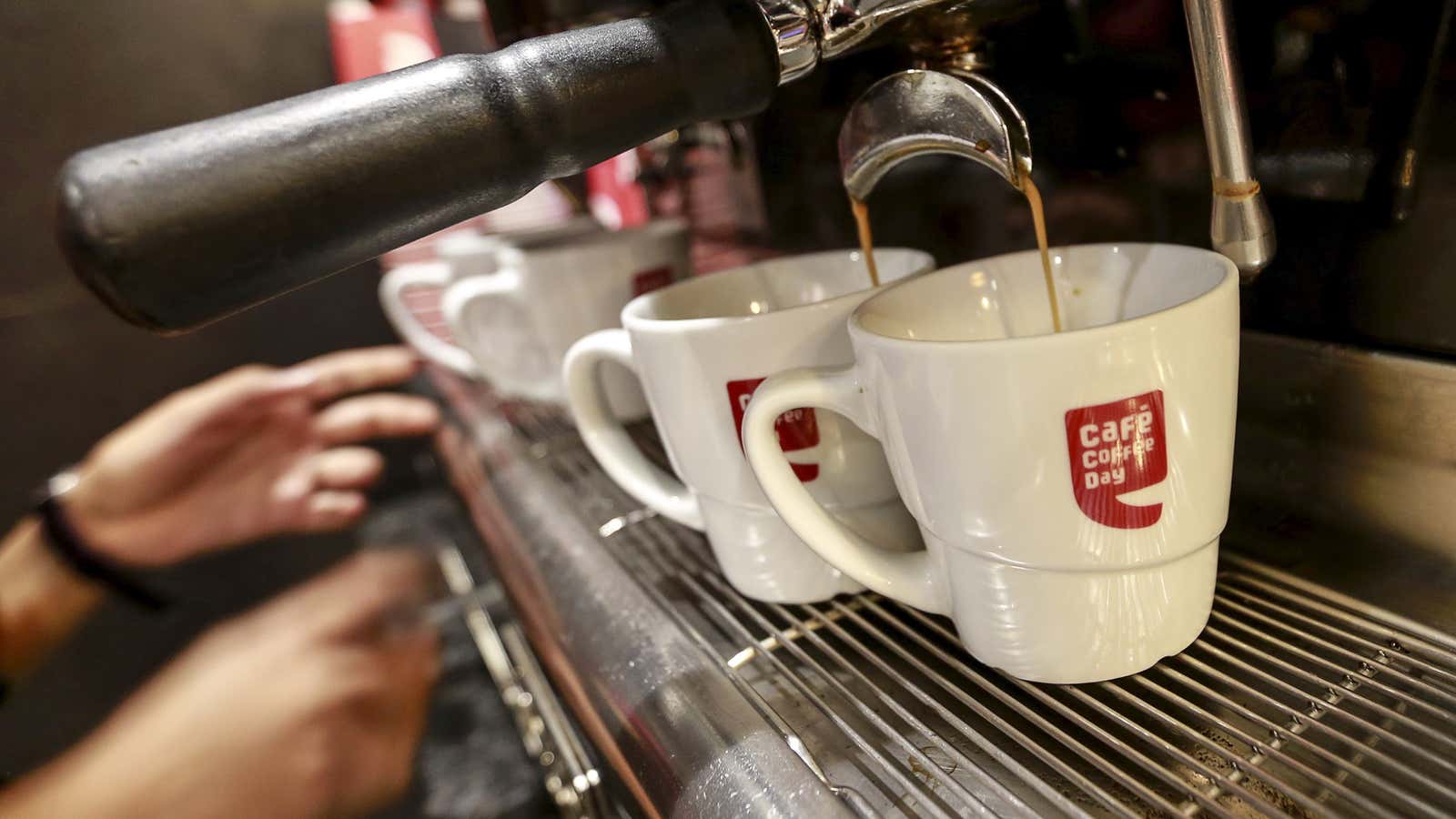The footprint of robot baristas is about to expand.
Austin, Texas-based Briggo this year is looking to increase the number of its totally-automated coffee machines from 13 to more than 100. The machines, each about 40 square feet in size, contain the technology needed to make a range of caffeinated drinks to order.
It was an idea hatched in 2009 by Kevin Nater and Charles Studor, two veterans of the tech and financial services industries. Studor had worked for Motorola; Nater at Citigroup and Dell. Together they saw an opportunity in an economy being recast by iPhones, apps, and Uber: Just tell a machine what you want using your phone, and within minutes a coffee will be ready and waiting for you.
Nater calls it an “autonomous non-human experience,” one of those bone-chilling techno-terror terms that seems to evaporate all the whimsy from an everyday exercise. To be sure, Briggo is an interesting idea, and nobody likes standing in line, especially in the hospitals and airports where the company hopes to expand.
“We’re closing in on our millionth drink,” Nater says.
Still, is there something to be lost when ordering from a machine?
We stare at our phones between doors—messaging friends, reading the news, catching scraps of Twitter while we hurry down busy sidewalks, sit on trains, or huddle uncomfortably-close with other commuters on buses. Maybe this modern ritual is escapism, temporary transport from mundanity. It might also be elected loneliness.
It’s in unexpected moments of self-awareness that I realize how alienating it is to stare into the personal black mirror affixed to my palm, scrolling through new emails and photos that people—many of them strangers—post to Instagram.
And then I look up.
“Let me guess: A double cortado with almond milk?”
The question bounces across the counter and elicits a smile. This is Jess. I don’t know her last name, but she knows the kind of coffee I like. She is a barista at a coffee shop not far from my office building.
“Yes,” I reply. “That’d be great.”
I’ve finished work for the day and I’m in desperate need of energy. Once a week for the last six months I’ve taken after-work Hebrew classes. It’s draining, exhilarating, terrifying, and fun. It moves muscles in my brain that I had forgotten since high school. But learning a languages requires energy, lots of it.
While the espresso machine hisses, I think to myself how I might order my coffee in Hebrew.
.אני רוצה קפה, בבקשה.
I want a coffee, please. (I don’t know how to say cortado. Or almond. Or milk.)
?אפשר אני יש קפה
May I have a coffee? (Can I say it that way?)
In a few months I’m supposed to travel to Israel, and I both relish and flinch at the prospect of talking to native speakers with my toddler-level vocabulary. Ordering coffee from an Israeli barista is a molehill that I’ve made into a mountain. What if he’s super-attractive and I fumble my words? What if nothing I say makes sense? What if…
But then I know that those are the moments—in the sloppy crucible of human connection—where a person actually learns something new. The small moments. My Hebrew will be corrected. My coffee will be fine. I’ll exit the cafe blushing regardless—breathless at my newfound ability or grateful the experience is over, at least until my next coffee order.
The unfettered, uncontrollable exhilaration of human connection distracted me from the phone in my hand, which somehow found its way into my pocket. But now, coffee in hand, I’m back outside and on my way to class. I pull it out and scroll through Slack.
“What happens if you try to order coffee from a robot in barely intelligible Hebrew?” I wonder.
Sure, it could guess what kind of coffee I want based on previous orders. The Briggo machine—which is restocked every one to three days—hits all the right cultural cylinders. It can make hot drinks and cold drinks. It can make them with almond milk, soy milk, fresh cow milk, and soon oat milk. It can do it in under under a minute. But would it be programmed to play along with my mistakes? Will it humor me? Laugh with me? Smile at me? Will it forgive me?
Of course, you don’t actually talk to Briggo. It’s a glorified vending machine that answers to orders made in an app—and at the same price point of what you’ll find at a Dunkin’. Nater actually describes it in an analogy. Briggo is to Starbucks as Redbox was to Blockbuster. A modern replacement in an economy built on a marriage between total optimization and new technology.
To Briggo, the barista is a variable to be eliminated. “This bean, it takes this unbelievable journey to that moment where the barista is having either a really good moment or not a good moment,” Nater explains. “The customer experience relies on that.”
And people appreciate it, Nater says. “The consumer is a wide demographic…younger, tech-forward, someone who uses the mobile app,” he says. “That’s becoming everyone. We found that all demographics loved the experience.”
I ask him about the absence of humanity in the process. He counters.
“The typical coffee drinker has a few coffees a day,” he explains, painting the picture of a corporate employee ordering a coffee, picking it up, and then chatting with fellow Briggo-drinking employees. Five of Briggo’s existing machines are in corporations that include Lockheed Martin, Dell, and Samsung. “We definitely feel the coffee moment provides that ability to connect.”
…אני תוהה
I wonder…
